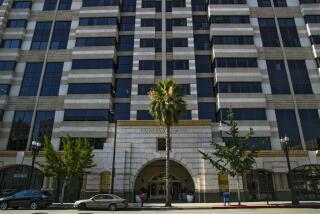Patlex’s Gamble on Laser Patents May Pay Off Soon : Victories on Behalf of Inventor Mean a 64% Cut of the Royalties for Company
- Share via
The legal gamble on which Patlex Corp. bet its future finally looks ready to pay off.
In the late-1970s, Patlex gambled that it could gain lucrative licensing royalties by helping Gordon Gould, a laser pioneer, convince the world that he was entitled to three patents on laser technology he developed 30 years earlier.
For waging the fight for Gould, who had failed to win the patents himself, Chatsworth-based Patlex would get 64% of any licensing income from Gould patents that were validated. Gould’s case, in effect, was about Patlex’s only major asset.
Gould himself would get 20% of the royalties and Refac Technology Development Corp., Patlex’s biggest stockholder, would get 16%.
The potential gain was clear. The use of lasers was rapidly expanding in research and industry, and Gould-related technology was dominant in laser development.
64% of Nearly Nothing
But the downside was just as clear. Few makers or users of lasers were willing to pay Patlex until Gould actually had the patents in hand, and there was no assurance Patlex would win Gould’s case. So, for much of Patlex’s existence, its take was 64% of nearly nothing.
There were plenty of litigation costs, however, leaving the company with $9.08 million in losses over the last six years.
And, without operating earnings on which to rely, Patlex’s stock, which is traded over-the-counter, would swing in tandem with Patlex’s victories and defeats in the U. S. Patent Office and in the courts.
“The only potential of the company was the patent, and to say it was speculative would be an understatement,” said Richard I. Samuel, a patent lawyer who became Patlex’s chief executive in 1982.
The prospect of the patent royalties “was an asset valuable, exciting and important, but not one we were comfortable having the entire company based upon,” he said in an interview.
Now, however, Patlex is resting a bit easier. The company has been winning major victories for Gould, increasing the likelihood that laser companies will have to pay Patlex and Gould to keep using the technology.
Court Victories
An important victory came two weeks ago when a federal appeals court ruled Gould was entitled to the patent on a so-called gas-discharge laser. The actual patent should be issued within three months, Samuel said.
Several months earlier, a Patent Office appeals board upheld Gould’s patent on another device, the optically pumped laser. The patent was first issued in 1977, but it then faced reviews and court challenges that left its validity in doubt until the appeals board ruled last September.
(Basically, the difference in the lasers is how they are powered. An optically pumped device uses light, whereas a gas-discharge laser relies on an electrical discharge in a gas.)
The upshot of the victories is that Gould is about to hold patents on the two main types of lasers sold in the Western world, which should strengthen Patlex’s ability to negotiate licensing agreements with the laser companies or to fight those companies that resist paying.
Case in point: Last month Lumonics, a major Canadian laser maker, agreed to pay licensing fees to settle a patent-infringement suit brought by Patlex. Lumonics agreed to pay an up-front fee of $500,000, plus a minimum $200,000 for each of the next seven years, to produce optically pumped lasers.
U. S. and Canadian sales of gas-discharge and optically pumped lasers, excluding military sales, will total about $230 million this year, according to Lasers & Optronics, a Torrance-based trade journal.
A flat royalty fee averaging 5% would produce licensing income of $11.5 million on those sales, and Patlex’s 64% stake in that income would total $7.4 million. Patlex’s actual 1986 revenue was $5.9 million.
“It takes the company from being highly speculative to being a real company,” said Christopher A. H. Lewis, managing director of MacKay-Shields Financial Corp., a New York money manager that owns about 350,000 Patlex shares.
Patlex’s other investors seem to agree. In the week ended June 27, during which the appeals court upheld the Gould patent on the gas-discharge laser, Patlex’s stock soared 26.4% to $16.75 a share, and Refac’s stock gained 25.6% to $12.50 a share. Both retreated a bit last week, however, with Patlex slipping to $15.50 a share and Refac to $10.75.
How much money Patlex actually makes will be subject to the specific fees it negotiates with each laser company, and to the outcome of Patlex’s third major battle--the fight over a so-called use patent that covers certain laser applications Gould contends he pioneered.
Appealed Ruling
Whereas the other two patents affect laser manufacturers, the use patent would affect the dozens of major companies that use the lasers, and they too could be subject to a licensing fee if they used the machines in ways developed by Gould. Gould’s claim to a use patent was rejected last September by a Patent Office appeals board, but Patlex has appealed the ruling to a federal court and expects a preliminary decision within six to eight months.
Samuel himself estimates that Patlex’s annual revenue, excluding any licensing fees from the still-questionable use patent, will reach $15 million to $20 million within two to three years. That would triple Patlex’s size. “There could be things occurring in the short term, but I’m comfortable with the idea that 18 months from now we will have substantially more revenue coming in than we do now,” he said.
He declined to predict whether Patlex’s losses will end this year, but added, “I expect 1988 to be profitable.”
Has Pact With GM
Patlex has benefited even without the use patent. Several large corporations that use lasers, including General Motors and Motorola, already have signed licensing agreements with Patlex on the expectation that the patent will eventually go to Gould.
Those agreements have helped keep Patlex afloat while it pursued the patents and sued alleged infringers. Patlex’s licensing income tripled last year, to $1.68 million from $530,200 in 1985.
In recent years Patlex also has expanded its own laser manufacturing business to generate some operating income and further finance the patent battle.
In June, 1985, the company acquired Apollo Lasers from Allied Corp. for about $3.4 million of Patlex stock, a stake Allied later sold to other Patlex shareholders. Patlex last October also purchased Oram Electric Industries, an Israeli maker of high-technology transformers, and in December acquired full ownership of another Israeli concern, Reschef Defense Technologies, an armaments firm Patlex helped start in 1984. Samuel predicted that those units together will post pretax operating income of about $1 million this year, but that the earnings “will be very likely eaten up by expenses associated with the patents,” with the legal expenses alone totaling up to $700,000.
Court Fight Not Over
Despite its apparent victory in obtaining the gas-discharge and optically pumped laser patents for Gould, Patlex will remain in court for a while.
The company, in an attempt to start collecting back royalties, is still suing several laser manufacturers for alleged patent infringement involving the optically pumped laser. Those suits had been put on hold for four years until the patent was upheld last September.
Samuel is confident that, with the patents in hand, Patlex can, if need be, get a court to block a laser producer from continuing to use the technology without paying a royalty.
“Things have now developed,” he said, “so that we’re going to have court decisions, we’re going to have events over the next 18 months that are going to crystallize this situation.”
More to Read
Inside the business of entertainment
The Wide Shot brings you news, analysis and insights on everything from streaming wars to production — and what it all means for the future.
You may occasionally receive promotional content from the Los Angeles Times.











